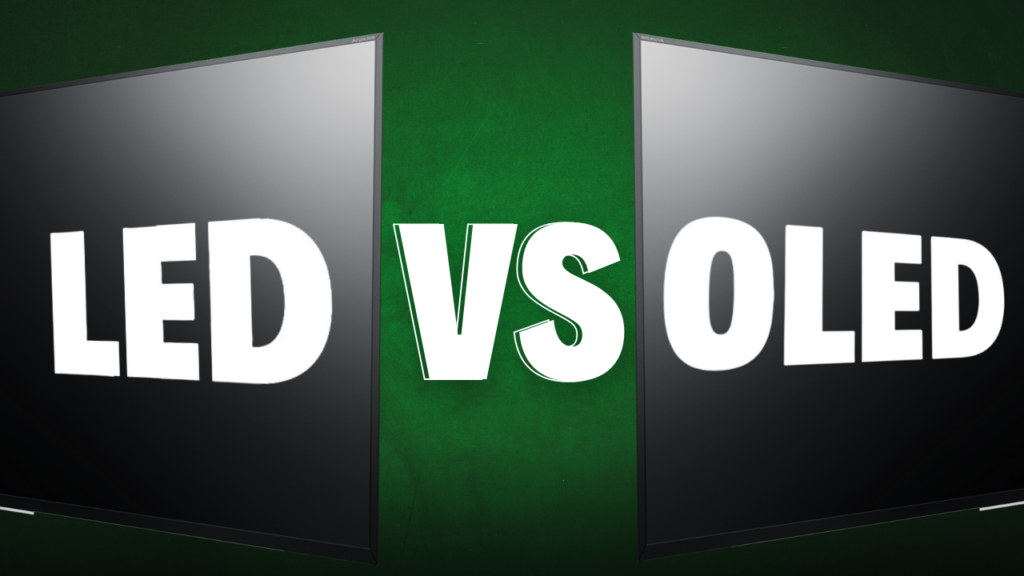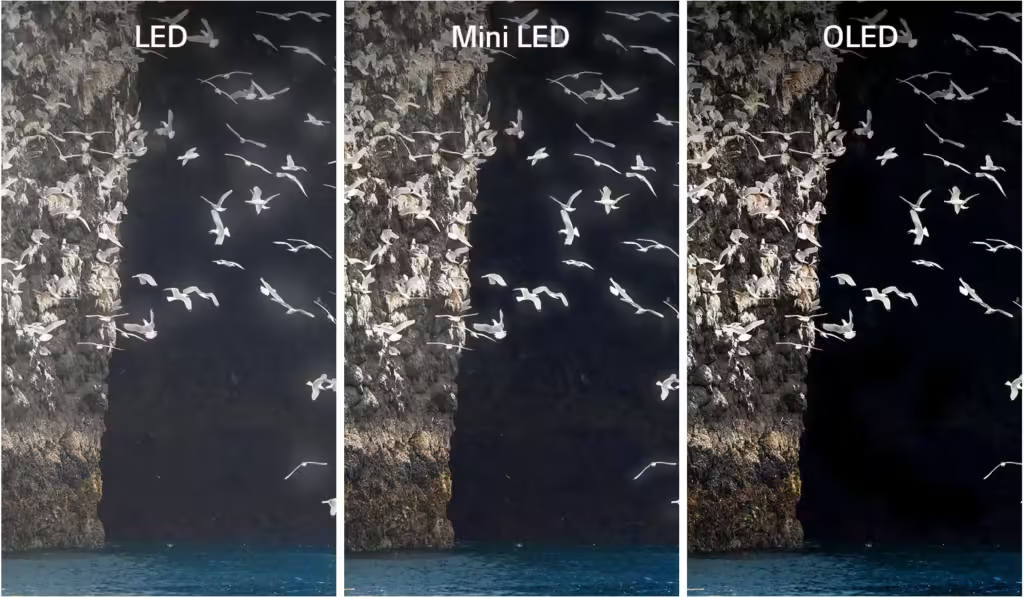
Introduction
When you’re deciding on a new TV, one of the key questions that comes up is LED vs OLED. LED TVs offer impressive brightness and versatility, while OLED displays are known for their deep blacks and excellent contrast. But the choice isn’t always as simple as it seems: each of these core technologies has evolved, giving rise to specialized types like QLED, Mini-LED, Neo QLED and QNED under the LED category, and QD-OLED and MLA OLED in the OLED family.
In this article, we’ll first break down the essential differences between LED and OLED to give you a clear understanding of what each technology brings to the table. Then, we’ll explore these newer, advanced variations that go beyond standard LED and OLED. Knowing about these options can make all the difference in finding a TV that truly enhances your viewing experience.
LED vs OLED
Understanding the Core Differences Between LED and OLED
When comparing LED and OLED, it’s essential to understand how each technology functions, as these differences impact everything from picture quality to energy efficiency.
How LED Works
LED, or Light Emitting Diode, is a backlit technology where a layer of LEDs provides light across the entire screen. This setup allows LED TVs to achieve high brightness levels, making them an excellent choice for well-lit rooms or daytime viewing. LED technology is versatile, with different backlighting techniques (like edge-lit and full-array local dimming) that enhance brightness and contrast.
Key Advantages of LED Technology:
- High Brightness: LED TVs can reach impressive brightness levels, ideal for rooms with natural or ambient lighting.
- Energy Efficiency: LEDs tend to consume less power than OLED displays, making them cost-effective for daily use.
- Wide Range of Options: LED technology spans a broad spectrum of price points, sizes, and features, making it accessible for different budgets.
Despite its strengths, LED TVs rely on a backlight, which limits their ability to display true blacks and reduces contrast in dark scenes. This is where LED’s evolved variants—such as QLED, QNED, Mini-LED, and Neo QNED—come into play, each enhancing some aspects of LED technology to compete more closely with OLED’s picture quality.
How OLED Works
OLED, or Organic Light Emitting Diode, operates differently. Each pixel in an OLED display emits its own light, allowing for “true” blacks by turning off individual pixels completely. This self-emissive nature creates extraordinary contrast and depth, providing a rich, immersive viewing experience ideal for movies and gaming.
Key Benefits of OLED Technology:
- Perfect Black Levels: OLEDs achieve deeper blacks by completely turning off individual pixels, which also contributes to remarkable contrast.
- Wide Viewing Angles: OLED displays retain color accuracy even from off-center angles, unlike many LED screens.
- Thin and Flexible Panels: OLED technology allows for ultra-thin designs, creating sleek, modern TVs.
OLED technology does have limitations, primarily in terms of brightness compared to LED. However, recent OLED advancements—such as QD-OLED and MLA OLED—seek to bridge this gap, pushing OLED technology to achieve higher brightness and better color accuracy.
Visual Comparison of LED, Mini-LED, and OLED

Exploring LED Variants: QLED, QNED, Mini-LED, and Neo QLED
QLED (Quantum Dot LED)
QLED, developed by Samsung, adds a layer of quantum dots between the LED backlight and the screen. This enhancement increases color range and brightness, allowing QLED TVs to shine in well-lit rooms.
Pros:
- High brightness
- Wide color range for vivid visuals
Cons:
- Limited black levels compared to OLED or Mini-LED
- Viewing angles can be narrower than OLED screens
Ideal For: Viewers who prioritize vibrant colors and high brightness for daytime or bright room viewing.
Mini-LED
Mini-LED technology reduces the size of individual LEDs in the backlight, allowing thousands of ilumination sections to fit within the panel. This improvement provides more precise light control, enhancing contrast and reducing “blooming” in darker scenes.
Pros:
- Enhanced contrast and detail in dark scenes when compared to QLED
- Improved light control with less blooming effect
Cons:
- Black levels still don’t match OLED’s quality
- Higher production cost may lead to a higher price
Ideal For: Those seeking superior image quality with improved dark-scene performance but not ready to invest in OLED.
QNED and Neo QLED
The Neo QLED (from Samsung) and QNED (from LG) technologies share several similarities. Both use Mini-LED technology for enhanced brightness and contrast, alongside Quantum Dot layers found in traditional QLED screens, which boost color vibrancy. However, QNED screens include an additional NanoCell layer—a unique feature to LG. This layer uses nanoparticles to filter and refine colors, resulting in greater color accuracy and richness, particularly for reds and greens.
Pros:
- Balanced brightness and color accuracy for versatile lighting
- Enhanced contrast and detail in dark scenes when compared to QLED
- Improved color accuracy through the NanoCell layer (only with QNED)
Cons:
- Still uses a backlight, so lacks OLED’s deep blacks
- Can be pricier due to advanced technologies layered together
Ideal For: Viewers who want a balance of high brightness, rich colors, and good contrast. These options are perfect for varied lighting environments where vibrant and accurate colors are essential.
Exploring OLED Variants: QD-OLED and MLA OLED
QD-OLED
QD-OLED combines OLED’s self-emissive technology with Quantum Dot layers, achieving deeper colors and a higher brightness level compared to standard OLEDs. It keeps OLED’s deep blacks but provides more vivid and bright colors, making it more versatile.
Pros:
- Maintains OLED’s perfect blacks with enhanced brightness
- Quantum Dot layer offers richer and more vibrant colors
Cons:
- Priced higher than standard OLEDs and LEDs
- Limited availability as it’s a newer technology
Ideal For: Users who want OLED’s contrast and color depth with added brightness for versatile room conditions.
MLA OLED (Micro Lens Array OLED)
MLA OLED utilizes a Micro Lens Array to increase light efficiency, boosting brightness and extending the panel’s lifespan. It’s ideal for those who love OLED’s quality but need higher brightness for daytime viewing.
Pros:
- Improved brightness, making it more suitable for well-lit rooms
- Better durability, thanks to the Micro Lens Array’s efficiency
Cons:
- Generally more expensive than standard OLED
- Limited to premium models due to complex manufacturing
- Slight loss of detail in darker scenes when compared to OLED or QD-OLED
Ideal For: Viewers seeking OLED quality with enhanced brightness for bright rooms or daylight viewing.
| Technology | Key Features | Pros | Cons | Best For |
|---|---|---|---|---|
| QLED | Quantum Dot layer for vivid colors | High brightness, wide color range for vivid visuals | Limited black levels, narrower viewing angles compared to OLED | Frugal users who want to view during the day or in bright environments |
| Mini-LED | Smaller LEDs for precise light control | Enhanced contrast, minimal blooming in dark scenes | Black levels still fall short of OLED, generally pricier than standard LED | Viewers seeking better contrast than QLED, but aren’t ready for OLED or QNED |
| QNED | Mini-LED + Quantum Dot + NanoCell for color accuracy | Enhanced contrast, color vibrancy boost, refined color accuracy | Lacks OLED-level blacks, often at a higher price | Viewers seeking better contrast than QLED, but not ready for OLED |
| Neo QLED | Mini-LED + Quantum Dot | Enhanced contrast and detail, color vibrancy boost | Pricey due to advanced layering, lacks OLED-level blacks | Frugal people who want a better experience than QLED |
| QD-OLED | OLED with Quantum Dot for brighter colors | Perfect blacks, vibrant color accuracy, increased brightness for OLED | Premium pricing, limited availability | Movie enthusiasts, those who prioritize depth |
| MLA OLED | Micro Lens Array for brightness boost | Brighter than standard OLED, great contrast, suitable for daylight viewing | High price point, Slight loss of detail in darker scenes | Bright spaces, OLED fans needing more brightness |
Conclusion: Choosing the Right Technology for You
Choosing between LED and OLED TVs, especially with so many advanced variations, can seem overwhelming. LED technology—including options like QLED, Mini-LED, QNED, and Neo QNED—offers impressive brightness and is often more budget-friendly, making it ideal for rooms with more ambient light. These variants take LED’s strengths further, providing vibrant colors and good contrast for versatile viewing.
In opposition, OLED technology, with options like QD-OLED and MLA OLED, excels in producing perfect blacks and maintaining exceptional picture quality from any angle, creating an immersive, theater-like experience, especially in darker rooms. Although OLEDs tend to come at a higher price, they deliver unmatched contrast and a depth of color that’s hard to beat.
In Summary: When deciding which screen is best for you, consider factors such as your room’s lighting, your preferred content, and budget. With a deeper understanding of the nuances of each technology, you’re now equipped to select a display that aligns with your specific needs, enhancing your viewing experience to the fullest.

1 thought on “LED vs OLED: Which Screen Technology Is Right for You?”